Mobert Crew’s Coho Ho Ho Adventure
Our Coho Ho Ho adventure. Where to start? I wanted to write a post about, “What To Expect When Running The Coho Ho Ho,” but since every trip is wildly different depending on the weather, the boat, the route, and the crew, I’ll give an overview of how our trip went; how and where we ran into trouble; and how we managed it.
We decided to do the trip nonstop. We did this for a few reasons. First, one of our crew had experience with the coast-hopping off Washington, and found the commercial traffic, crab pots, and logs distasteful (and downright dangerous). Second, we wanted real offshore experience. We had a great opportunity to do that during this run, with the girls safely with my parents, and four total adult crew on board. So, we went the offshore, straight-shot route from Neah Bay to Half Moon Bay. Of course, if there wasn’t wind, we’d be motoring a lot and have to refuel in Newport, Oregon, but a straight shot was our goal.
For crew, we had the perfect complement. In addition to Rich and me, our crew included my dad (George) and a friend of mine from law school, Tracy. My dad has been sailing his whole life, and has offshore experience. He’s one of those seasoned sailors who’s forgotten more about sailing than we’ll ever know. Tracy is preparing for her own Big Left Turn, and has great passage experience, but nothing offshore. Rich and I know the boat, but had neither passage nor offshore experience. Put us together, and we just might make it down the coast together alive!
One Day Before Departure
We arrived in Anacortes on Friday, September 8. The boat wasn’t back in the water yet when we arrived, and the fabulous crew at Marine Servicenter splashed her mid-day. We had half a day to pack, fill water and fuel, and do a few last-minute projects that were required before we left port, including checking oil and filters to ensure the engine wouldn’t fail us. It was a whirlwind, but we managed to get the boat put together and ready in time for a late dinner.
Day 1 (Saturday, September 9)
The next morning, we left at 6AM, in near darkness, to catch a favorable current in the Strait of Juan de Fuca. We did a quick safety briefing with the crew, which included an overview of on-deck and in-cockpit rules and on-board safety equipment.
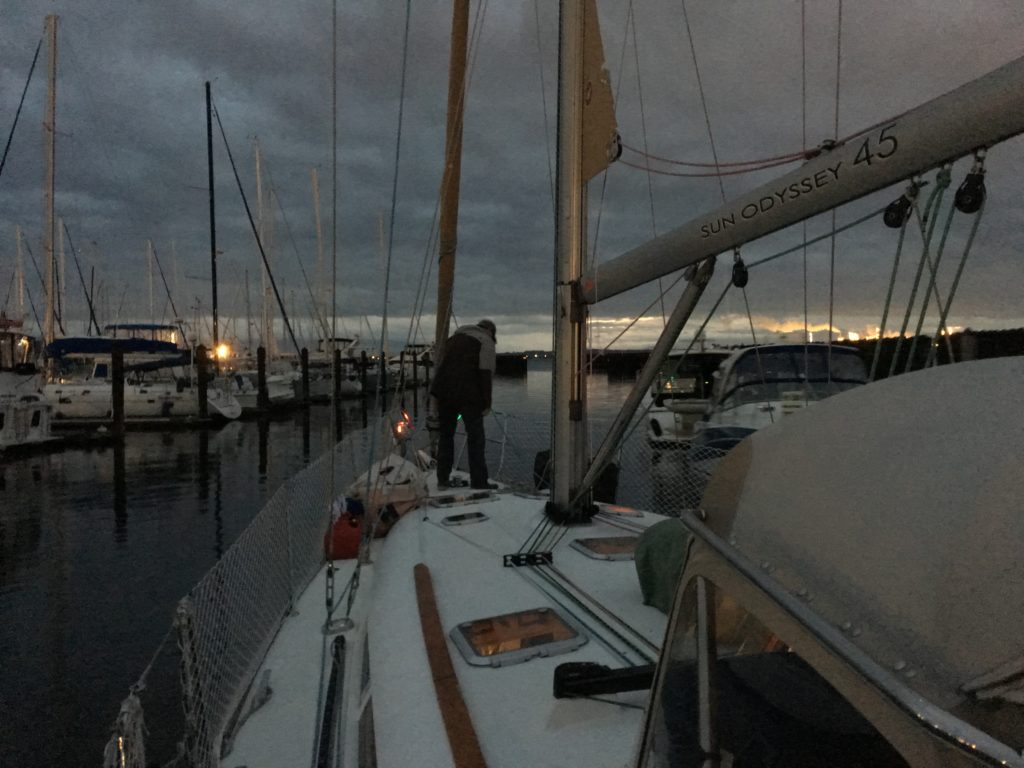
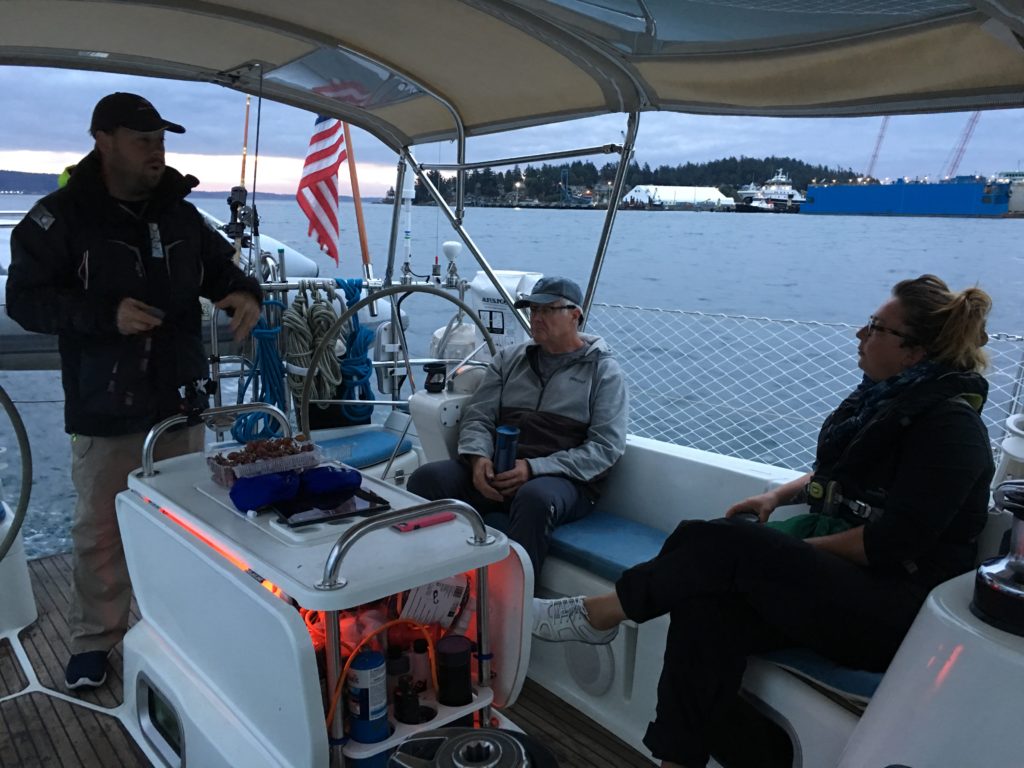
The wind was light and on the nose, so we motored the entire 11 hours to Neah Bay. We dropped anchor in Neah Bay around 7PM, and had an all-crew dinner as we chatted about the days ahead, including routes, weather, and watch schedules. We headed off to bed early to get rested up before our Big Left Turn the next day.
Day 2 (Sunday, September 10)
Dad and I pulled up the anchor around 7AM, and motored out of Neah Bay. The crew enjoyed a breakfast of egg and veggie wraps I’d pre-made and frozen, to ensure we always had fuel readily available for the crew. (These were really good when I first made them, but after trying for years, I’ve now concluded that frozen eggs just aren’t palatable. So, the wraps were a good idea, but didn’t work out as I’d hoped for this trip.) The seas were calm and the wind was light as we rounded Cape Flattery and Tatoosh Island.
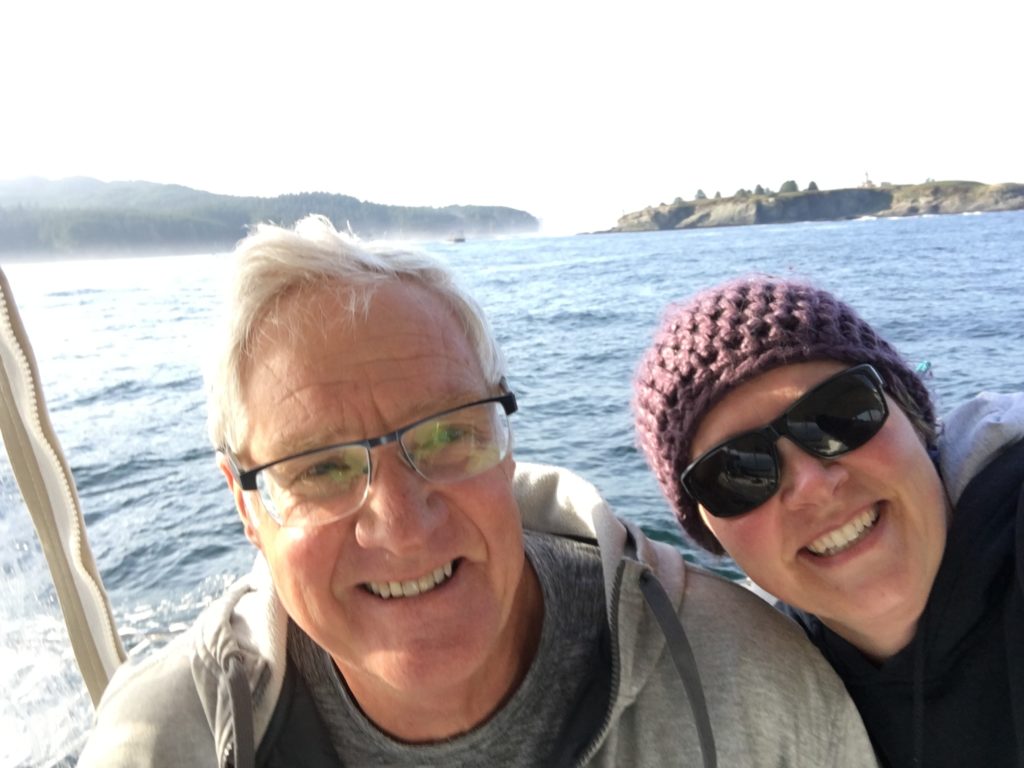
We turned left 45 degrees and set our course for 60 miles west of Cape Flattery.
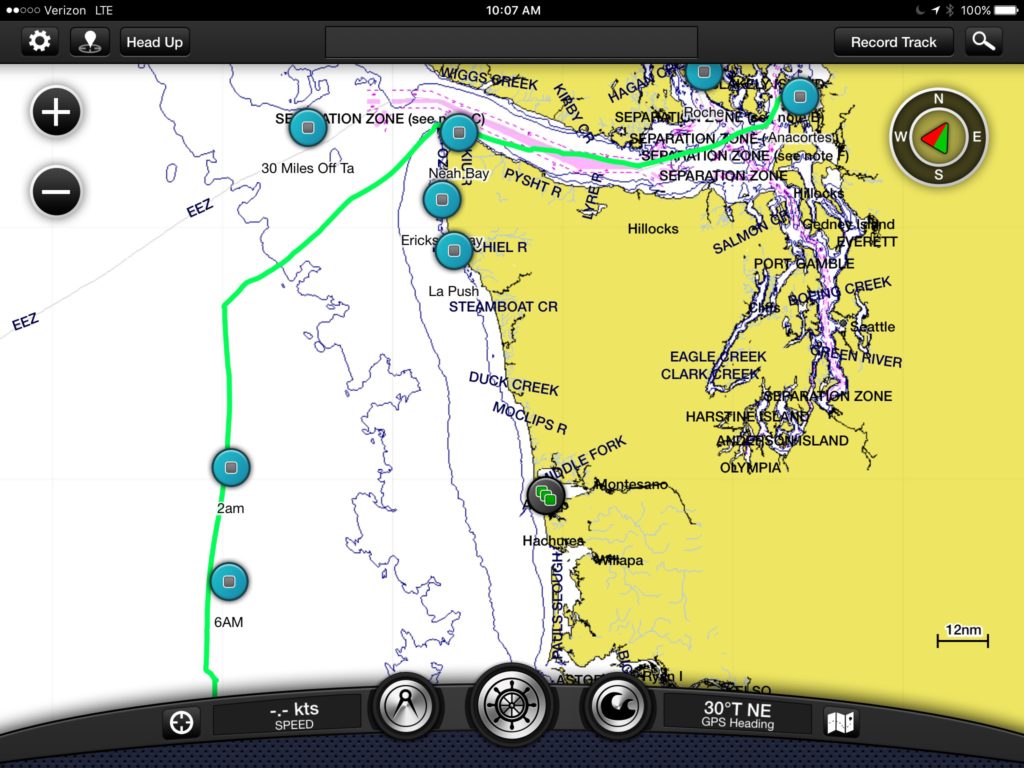
Based on our research and advice from others, the 60-mile line was a good route because it avoided the crab pots, logs, and commercial traffic found closer in; unpredictable seas caused by the rising shelf; and typically nasty weather off Cape Mend0cino far to the south. On the other hand, it was close enough in to catch the prevailing northwesterlies while minimizing transit time back toward land later on. So, about sunset that first day, we turned due south and continued motoring.
We had a nice, calm motor all night long. This was perfect to ease us into the routine of night watches, as I personally had never been out after dark. The moon lit our way most of the night, and we had a great first night.
Day 3 (Monday, September 11)
By morning, we made it to Oregon. We were surprised how dramatically the shipping traffic dropped off once we passed the Columbia River. The winds had picked up, so we put up the sails. At this point, I had been seasick for two days straight, going on three. It was a strange seasickness, with something about it that I still can’t identify feeling different from normal motion sickness. It was also strange because it started on the first day, which was a relatively calm day in the Straits, when I normally wouldn’t have been sick at all. I was using the seasickness patch for the first time (scopolomine), and I thought that might be the culprit, so I decided to take it off. Within hours, I was feeling better. Not completely well, but noticeably improved. What a relief!

The winds were light all day, so we motor-sailed for portions of the day as we plugged along off the southern Washington coast. We also got a hard lesson in offshore jibing, as well as hatch-closing. It was mid-day, and Tracy and I were on watch, with my dad resting downstairs, and Rich attempting to nap in the v-berth. We had sailed fairly far out and had almost reached our 60-mile offshore line, so it was time to jibe back in.
I knew from prior experience that jibing was tricky. We couldn’t just bring in the main tight and then do our jibe, because if we did, the tight main would blow the entire boat around. So, I brought the main in as tight as I could without losing steerage, and left some play on the traveler, so that when the main did come around, it wouldn’t come hard. Then, with Tracy at the helm and me on the lines, we jibed.
It was then that we learned that offshore jibing is nothing like Salish Sea jibing. In the Salish Sea, it’s fairly easy to bring the boat around nice and slowly while one person manages the sails. In the open ocean, however – with some significant swell – we discovered the hard way that losing the wind completely – and therefore control of the boat – isn’t that hard. Just as we turned dead downwind, the boat slid into a trough between swells, and the wind disappeared. Without any wind, we lost steerage of the boat. She was spun around inside the trough so that we were facing the approaching rollers, and plunged bow first into the wall of water ahead of us. Quickly, we started the motor to regain control, and put the sails back together. A little rattled, we sat down, crisis averted – or so we thought.
It was then that Rich popped his head up into the cockpit. He hadn’t slept the prior night, so we were surprised that he wasn’t still downstairs in the v-berth, trying to sleep. Sure, we came around quickly, but we got it all put back together and there was no reason for him to wake up.
Or so we thought. As he climbed the companionway stairs, we saw that his clothes had wet spots, like splashes, all over. He didn’t look happy. “What happened?” I asked.
What had happened was that we filled the v-berth with a solid 50 gallons of sea water. We didn’t know it, but when we plowed bow-first into the wave during our ill-conceived jibe, the hatches in the v-berth were open. The water poured in, and for a moment, Rich thought the boat might be sinking. But it was only one (very significant) dump of water inside. Rich was wet, our bed and bedding was wet, and water was still sloshing around the v-berth floor, until the seas tossed us in the right direction to drain it to the bilge pump.
Later that evening, as we sat in the cockpit eating dinner together (which Tracy generously made, as I was still feeling far too sick downstairs, and still a little sick upstairs), we discussed the evening’s night watch schedule. The first night, Rich and Tracy took the 8-2 shift because they’re naturally more night owls. My dad and I are morning people, so we were in bed by 8PM so we could wake up by 1:45 for the shift change.
But tonight, Rich was having some issues. As Tracy was making dinner, I went downstairs to check on him, and found him in the v-berth crying. Very concerned, I asked what was wrong, and he said he had no idea. I asked if he’d been able to nap all day, and he said no. It was clear that he was simply exhausted, and desperately needed sleep. So, my dad and I took the first shift so Rich could get some MUCH-needed sleep.
Despite the fact that the wind had picked up to about 15 knots from the north, the night was still warm. The swell was picking up, about 6-8 feet, but with a long period and following seas, so we sailed comfortably along with both the main and jib up. Unfortunately, we weren’t able to make very much progress south because the wind was from due north, so we jibed in toward land most of the day. At 10:45PM we were only 30 miles offshore, so we jibed back out to sea.

Although I wasn’t as tired as Rich, I was sure tired that night, which surprised me because I’d gotten a good nap in during the day. I wasn’t tired in that I had trouble staying awake, but wow, did I have some amazing hallucinations! Throughout the night, I saw a skeleton pirate climbing up our back swim step; a ghostly pan-like man-goat figure standing up by the mast; and a black bear sleeping on the salon floor. Luckily, I knew they were hallucinations, so they were more fun and amusing than scary. But, seeing all those things was a clear sign that my brain was in desperate need of dream-sleep.
At 2AM, Rich and Tracy came on, and my dad and I went down to sleep. After six hours of sleep, including dream-sleep, Rich seemed refreshed and ready to go. While Dad and I slept, Rich and Tracy enjoyed a dramatic moonrise thanks to smoke from the Oregon forest fires, followed by a well-lit second watch.
Day 4 (Tuesday, September 12)
I enjoyed a good sleep until about 9AM or so. I was feeling pretty well when I woke up, so I took my time brushing my teeth, washing my face, and freshening up. As I did so, I became more and more queasy, and soon had to stop and head upstairs. I managed to get back downstairs long enough to pour myself some cereal with coconut milk (which turned out to be a winning combination for both Tracy and me during our offshore passage), and I felt better – but again, still not 100% – after having a little food.
By the time I awoke, we still weren’t making the progress south that we needed to in order to complete the trip in a reasonable amount of time. The wind had picked up to 15-20 knots from the north, so we decided to try furling the main and sailing on the jib only, so we could point more directly south. With the wind up and the main down, we made much better southing that day.

The crew all managed to get decent naps in, which was critical – my dad’s offshore experience has been that a solid 1-2 hour nap plus an uninterrupted 6-hour sleep each day seemed to keep everyone sane. That definitely matched our experience, so we made a concerted effort to make sure everyone got their 6 hours during the night, plus a significant nap, each day.
Still I felt sick. I drank as much water as I could manage during the trip to ensure I didn’t get dehydrated, but I didn’t feel like eating much. I had a few pieces of fruit, and would pick at some of the fabulous meals Tracy made us, but I just couldn’t manage much food. But that evening, Tracy made a delicious and very hearty potato-cabbage-polish sausage dish. After a bowl of that, I suddenly felt exponentially better. I had a great evening, finally with some energy. Maybe I just needed to eat more to get rid of this lingering seasickness?
That evening, we were back to our watch schedule where Rich and Tracy handled the first 8-2 shift, and my dad and I took the second, 2-8 shift. When I came up at 2AM for the shift change, I found Rich and Tracy each laying down on either side of the cockpit, looking at the stars through the light in the bimini. They said they’d had a great shift, hadn’t touched the sails, and all was calm. They headed down to bed and left my dad and I on watch.
We had planned to spend the entire night jibing out to sea, in part to make the night watch easier with fewer potential obstacles, but also to avoid a gale forming around Cape Mendocino. Inside the gale, the winds and seas were howling. Outside, it was dead calm. We hoped to find that sweet spot on the edge of the gale where we had enough wind to sail, but not too much wind.
By the 2AM shift change, however, we were losing our wind. So, my dad and I decided to jibe back in to try to find the edge of the gale and continue sailing. We did, and within two hours we were in 30 knots and nearly fully reefed on the jib, so we jibed back out to sea. On the edge of the gale, the swell was angry and confused. We had a long, tense night with big, steep swell on the side from the west rolling us farther over than I was comfortable, with competing and significant wind wave action from the north, and on the edge of being overpowered by the wind. We took several waves across the back of the cockpit (which thankfully didn’t make it to the main part of the cockpit thanks to the side curtains on our bimini), and by the end of the night I was terrified and exhausted.
Day 5 (Wednesday, September 13)
My adrenaline was too high to sleep for several hours after our watch. The seas were a steep 14 feet, with occasional waves even higher. Each wave loomed up behind us, threatening to break over the back of our cockpit, but never reaching past the swim step. By now, and despite my fatigue, I’d learned to trust our boat, and knew she could handle it.
We were tired of being tossed around, so that morning we decided to head straight into the gale. The winds were reported to be steady at 35, with higher gusts, and big seas. But, the seas where we were, on the edge of the storm, were confused and rolly. If we headed into the storm, we thought, we would have high winds but a more steadily following sea. We could manage the high winds with reefing, and a following sea – even large seas – would be far more comfortable than the washing machine we’d found ourselves in.

Our gamble paid off. As we made our way closer to Cape Mendocino, the wind and seas increased, but the seas also calmed. Still sailing jib-only, we reefed down until less than half the sail was out. With gusts over 35 and the sail set well, we cruised along at a steady 7-8 knots over ground, sometimes reaching 14 knots surfing down the large swell. The day was rough, but we made good progress in manageable seas.
I spent the morning napping. As soon as I woke up, within 10 minutes, I made myself eat. I wasn’t hungry, but I put down a bowl of Cheerios and coconut milk anyway, and discovered that having food immediately after waking up – as in, within minutes – was the best way to minimize my queasiness.
Tracy and my dad took the first watch that night, while Rich and I tried to sleep in preparation for the second watch. Although I found it easy to sleep in the v-berth alone in the big seas, Rich and I were now sharing the bed. Neither of us got much sleep, as we kept getting tossed on top of each other.
At 2AM we made the shift change, and we continued sailing through the night. Luckily, the winds had calmed from the 35 we were seeing during the day down into the 20s, so our night watch was relatively easy.
Day 6 (Thursday, September 14)
The wind picked up again the next morning, blowing a steady 30. So far, we’d made it 751 nm through the water, and 769 nm over ground. It was the first day that we really felt like the passagemaking was manageable. I was still a little sick, but mostly not sick so long as I ate plenty of protein and carbs. We’d figured out our sleep schedules, and our bodies were adjusting. Our bodies were also beginning to adjust to the constant movement of the boat. Finally, we were getting into the swing of things. It was almost disappointing that we were expecting to make landfall the next day, since for the first time we felt like we could do it!

The winds continued to blow about 30 all day, and then died down to 25 overnight. About sunset, the winds finally became the prevailing nor’westerlies we’d expected the entire trip. Tracy and my dad took the first night shift. We’d discussed reading straight from the 7PM waypoint to Half Moon Bay, but in the dark Tracy and my dad chose not to navigate near the shipping lanes and between the Farallon Islands, so shortly after their watch started, they jibed due south.
Rich and I took the second watch together. At 3AM, we were almost too far south – we were nervous about having to make a broad reach in 20+ kt winds the next day to get into Half Moon Bay. So, we set the sails and pointed at our destination. It was exciting knowing that we on our last jibe.
Tracy, who’d been doing all the cooking and dishes for everyone, was tired. The seas were big overnight, and she had trouble sleeping because she was getting tossed around. She laid downstairs in her berth watching our track on her phone, and what she saw made her panic. We were heading straight for the Farallon Islands!
She jumped out of bed and up to the cockpit. “You guys know we’re headed straight for the Farallon Islands, right?” Rich and I were confused. The Farallons were still 40 miles off – we wouldn’t be anywhere near them until morning. But Tracy was insistent that we were headed straight for them. We did our best to assuage her and get her back to her bunk, because it was clear that a good night’s sleep would do far more to help her peace of mind than a course change at that point.
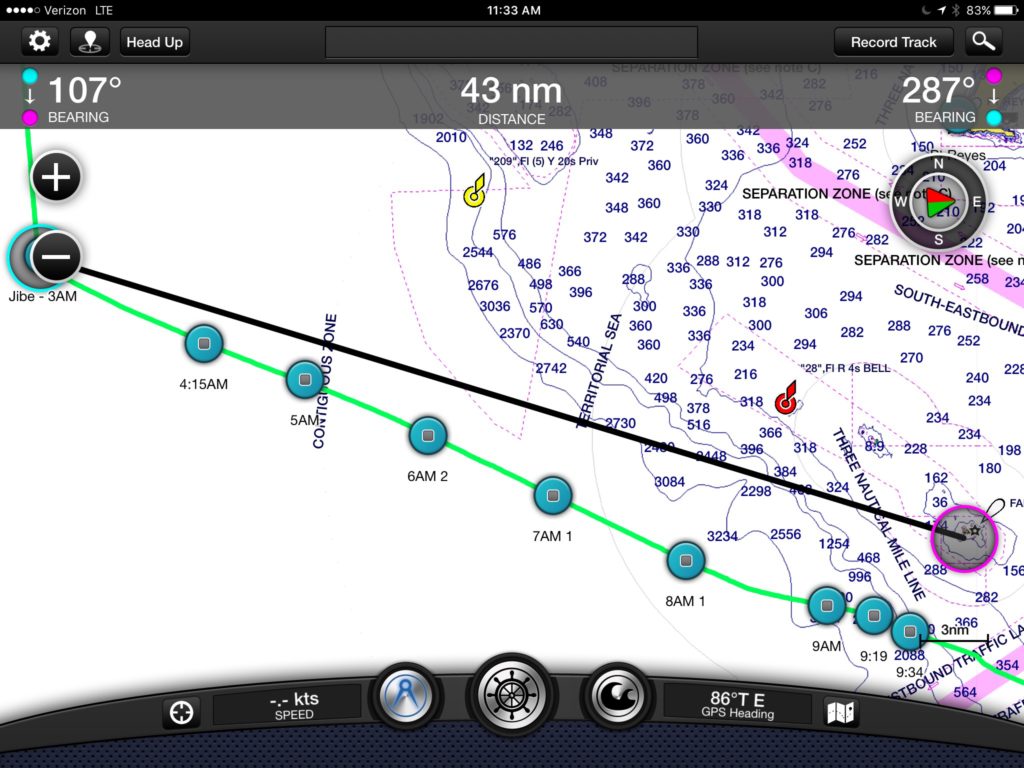
The rest of the night was uneventful, and the wind steadily fell off as we headed toward land.
Day 7 (Friday, September 15): LANDFALL!
The next morning, the wind was lighter – only 10-20 kts – and these horses were smelling the barn. So, rather than slowly drift-sail toward Half Moon Bay all day, we fired up the motor and made our landfall around noon. I had no huge sense of relief or achievement like I’d expected; it felt little different from landing in any other port. Too tired to even shower (except for Rich, who somehow snuck in a shower on our way in and came on deck looking like a Dockers model – making the rest of us look even worse), we went out to dinner together to celebrate. It was anti-climactic, and we all ended up in bed early. It felt strange to be in a stable berth for the night.
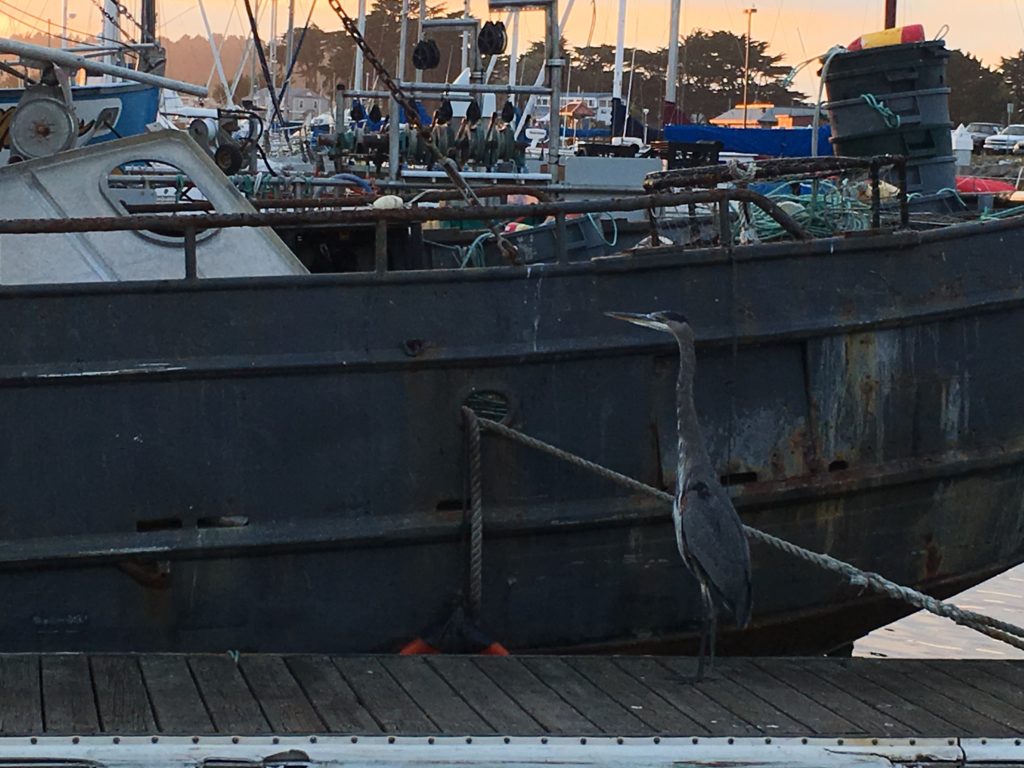
Tracy and my dad left the next morning, and just like that, the adventure was over. In some ways, it felt like it never even happened. In other ways, it felt like any other day on the boat. But, we’d done it. Our first offshore passage, our first week at sea. We were now offshore sailors.



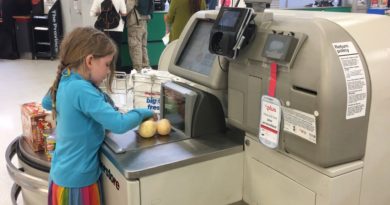

Pingback: Schooling and Beaching in Avila Beach – Andersons Abroad
Pingback: Costs of Cruising The U.S. West Coast – September 2017 – Andersons Abroad